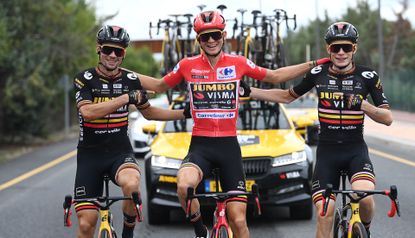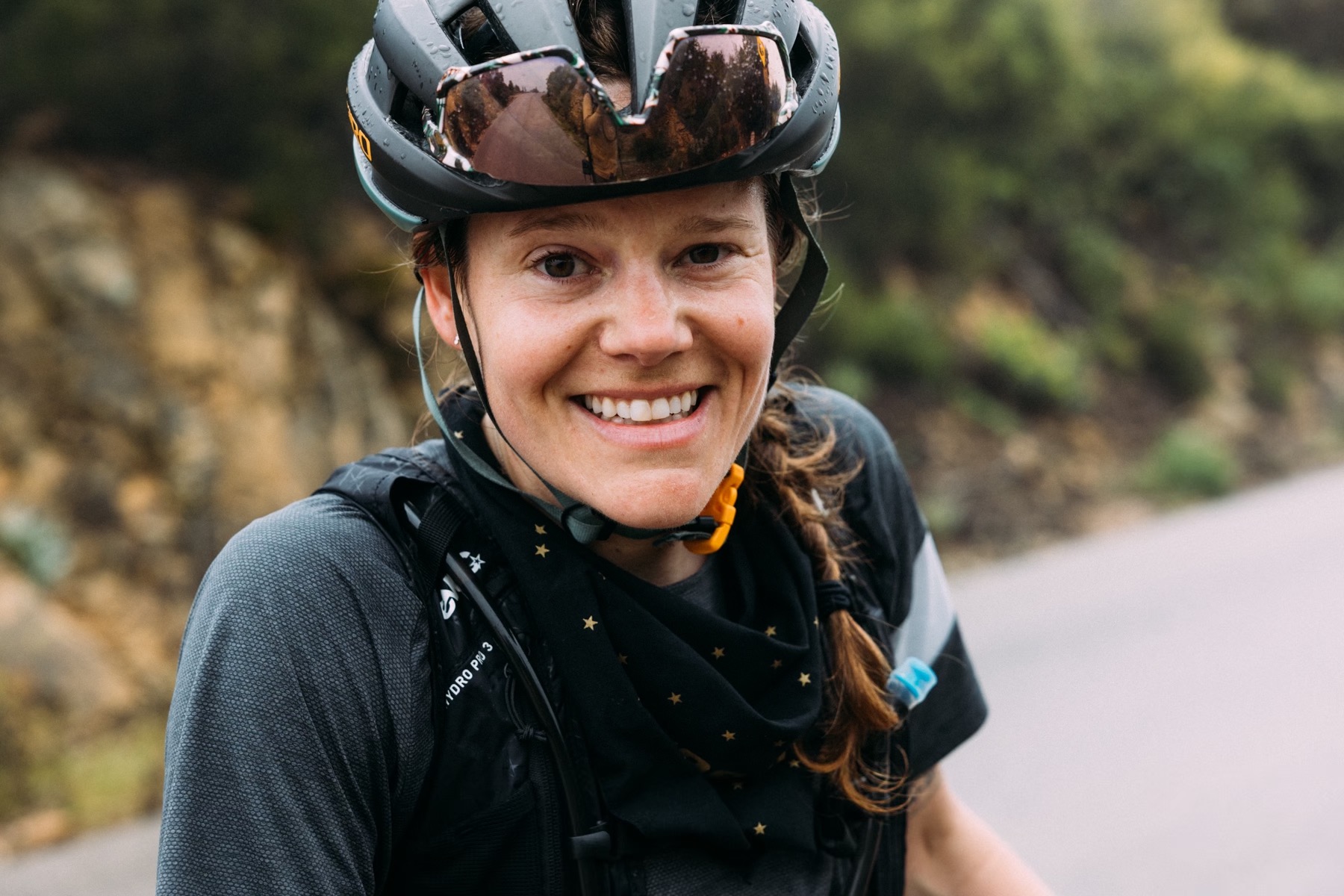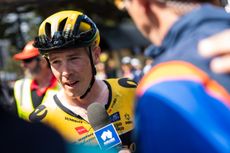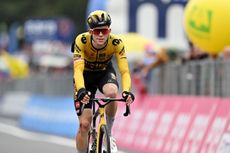From 'mailman' to maillot rojo: Sepp Kuss becomes first American to win a Grand Tour in a decade
Kuss is also second American ever to win La Vuelta


Rolling from the start line of the processional Stage 21 arm-in-arm with Jumbo-Visma leaders Jonas Vingegaard and Primož Roglič, American Sepp Kuss continued to celebrate his unexpected win of 2023 Vuelta a España on Sunday, Sept. 17.
The celebration started at the end of Stage 20 on Saturday and continued the next day with a reception of an all-red "GC Kuss" race bike and plenty of media fanfare. In winning the Vuelta, Kuss became the first American to win a Grand Tour in a decade, and the second American ever to win the Spanish tour.
The 29-year-old Coloradan earned the red jersey after stage eight, taking the lead from Lenny Martinez (Équipe Cycliste Groupama-FDJ). He then managed to keep it all the way to Madrid, 13 stages later.
"I think it’s an honor to wear the red jersey…I will try and enjoy it because it’s not something I will experience very often,” the super-domestique said that day.
Kuss has long been celebrated for being one of the best helpers in the peloton, and a key player in helping his teammates Primož Roglič and Jonas Vingegaard win the Giro d'Italia and the Tour de France. He's been Instrumental in the success of both front men and watching him ride in the red jersey seemed like a storybook ending for the Dutch squad. But it didn't come without some drama in the final week, as Jumbo-Visma struggled with its team strategy, seemingly unable to see the race win go to its domestique instead of its leaders.
As fans across the world called the team out for its questionable antics, squarely placing themselves in "Team Kuss" so did Vinegaard and eventually, Roglič. In the end, all three winners stood atop the podium in Madrid, with Tour de France champion Vingegaard in second place and Giro d'Italia winner Roglič in third.
Jumbo-Visma made history for becoming the first team to claim all three Grand Tours in the same year — something that was celebrated with the unveiling of a new team kit. On Sunday, the Dutch squad swapped its yellow colorway for an all-black outfit with pink, yellow and red touches to signify the season's Grand Tour victories.
A Strong Showing this Season

Now in his eighth year of being a pro, Kuss is known for being one of the best climbers in the world, even if he's usually riding in service of his Jumbo-Visma teammates. So much so, that in the 2023 Tour de France, Kuss's teammates nicknamed him “the mailman” because he “always delivers” as a super-domestique.
That is not to say he hasn't had his own successes. Kuss has won stages at both the Tour de France and La Vuelta and finished fifth overall at this year's UAE Tour.
Fans will remember that Kuss was also looking strong in the General Classification of this year’s Tour de France until a nasty crash in stage 20 tumbled him out of the top 10.
What is the Red Jersey?

The red jersey was introduced in 2010, the year Vincenzo Nibali won the Grand Tour.
The red jersey, or the maillot rojo, of La Vuelta a España is worn by the leader of the general classification — in other words, by the current race leader. The maillot rojo is equivalent to the yellow jersey (the maillot jaune) awarded to the race leader in the Tour de France and the pink jersey (maglia rosa) in the Giro d'Italia.
The red jersey wasn’t always red, though — it was first white, then yellow, then gold until 2010 when Mark Cavendish had the honor of donning the inaugural red jersey as part of the HTC-Columbia team after the opening team time trial.
The jersey was changed from yellow to gold to try to be distinct from the Tour de France’s yellow jersey), but after complaints that the gold jersey didn’t look much different than a yellow one, red was decided upon to be distinct to La Vuelta.
General classification leaders are based on their overall time for the entirety of the race thus far. The rider with the lowest overall time becomes the general classification leader, and in the case of La Vuelta, the wearer of the maillot rojo.
To keep the red jersey, a rider must continue to have the total fastest time across all stages. This does not mean that the rider needs to win every stage; they just need to maintain the total fastest time for all completed stages.
Kuss won with a 17-second lead over his teammates. The first non Jumo-Visma rider in the overall standing was Juan Ayuso from UAE.
Americans Who Have Worn the Red Jersey

Chris Honer in the red jersey at La Vuelta in 2013
Kuss is only the second American male to have worn, let alone won, the maillot rojo. The only other American male to do so was Chris Horner in 2013 when he won La Vuelta at the astounding age of 41.
In fact, Kuss is the first American male to lead any Grand Tour since Horner's historic ride in 2013. What's more, Kuss joins a very exclusive list of American riders to have officially won a Grand Tour. Not counting the tainted U.S. cycling era, Kuss is only the fourth American after Greg LeMond, Andy Hampsten and Chris Horner.

Thank you for reading 20 articles this month* Join now for unlimited access
Enjoy your first month for just £1 / $1 / €1
*Read 5 free articles per month without a subscription

Join now for unlimited access
Try first month for just £1 / $1 / €1
Get The Leadout Newsletter
The latest race content, interviews, features, reviews and expert buying guides, direct to your inbox!

Cycling Weekly's North American Editor, Anne-Marije Rook is old school. She holds a degree in journalism and started out as a newspaper reporter — in print! She can even be seen bringing a pen and notepad to the press conference.
Originally from The Netherlands, she grew up a bike commuter and didn't find bike racing until her early twenties when living in Seattle, Washington. Strengthened by the many miles spent darting around Seattle's hilly streets on a steel single speed, Rook's progression in the sport was a quick one. As she competed at the elite level, her journalism career followed, and soon she became a full-time cycling journalist. She's now been a cycling journalist for 11 years.
- Kristin JennyFreelance Contributor
-
 Rohan Dennis charged with causing death by dangerous driving following death of wife Melissa Hoskins - reports
Rohan Dennis charged with causing death by dangerous driving following death of wife Melissa Hoskins - reportsHoskins, the two-time Olympian, was killed in a car crash on Saturday
By Adam Becket Published
-
 GripGrab Women’s Windbuster Windproof Lightweight Vest review - minimalist design executed well
GripGrab Women’s Windbuster Windproof Lightweight Vest review - minimalist design executed wellA two-zipper and a mesh rear panel really help aid temperature regulation and work excellently with the front windshield
By Anna Marie Abram Published
-
 Lotte Kopecky, Sepp Kuss, Mathieu van der Poel: Cycling Weekly writers pick their standout riders of 2023
Lotte Kopecky, Sepp Kuss, Mathieu van der Poel: Cycling Weekly writers pick their standout riders of 2023Our writers pick their best riders of a scintillating year. Have we missed anyone out?
By Adam Becket Published
-
 Will Sepp Kuss spark a US road cycling revival?
Will Sepp Kuss spark a US road cycling revival?It’s been some 15 years since we saw such an exciting contingent of American riders in the WorldTour; there’s hope their ember can spark a fire in the hearts of American sports fans
By Anne-Marije Rook Published
-
 Michel Hessmann anti doping positive a ‘black day’ for Jumbo-Visma says boss
Michel Hessmann anti doping positive a ‘black day’ for Jumbo-Visma says boss22-year-old German rider suspended by Dutch team in August after positive test revealed presence of diuretics
By Tom Thewlis Published
-
 How much did Sepp Kuss and Jumbo-Visma win at the Vuelta a España 2023?
How much did Sepp Kuss and Jumbo-Visma win at the Vuelta a España 2023?Turns out locking out the podium for much of the race gets you quite a few Euros
By Adam Becket Published
-
 Five things we learned from the Vuelta a España 2023: Sepp Kuss is the real deal and Ineos still lacking
Five things we learned from the Vuelta a España 2023: Sepp Kuss is the real deal and Ineos still lackingHere's what we learned from the final Grand Tour of the 2023 season
By Tom Thewlis Published
-
 Sepp Kuss set to win historic Vuelta a España as Wout Poels claims stage 20
Sepp Kuss set to win historic Vuelta a España as Wout Poels claims stage 20American poised for an unexpected but worthy Grand Tour victory in Madrid
By Tom Davidson Published
-
 Tweets of the week: A Sepp Kuss and Tour de Tietema special
Tweets of the week: A Sepp Kuss and Tour de Tietema specialIt might be hot as hell in the UK this week, but that does not mean the social media content stops
By Adam Becket Published
-
 Tour de France on circuits or charging for mountain spots - Jumbo-Visma boss’s answers to fan collisions
Tour de France on circuits or charging for mountain spots - Jumbo-Visma boss’s answers to fan collisionsRichard Plugge says the number of fans causing crashes is “getting worse every year”.
By Vern Pitt Published








